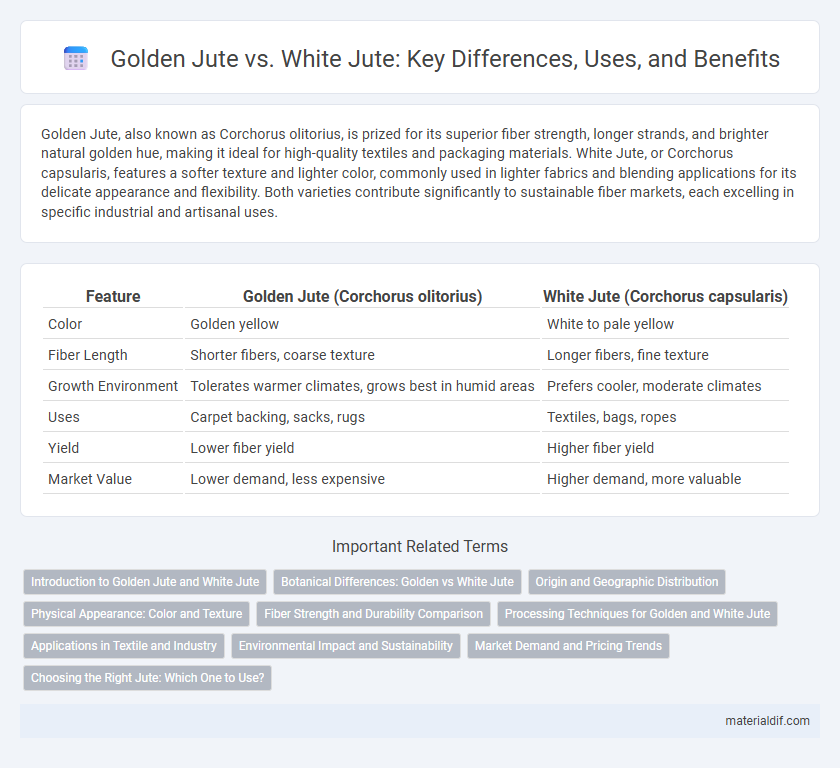Golden Jute, also known as Corchorus olitorius, is prized for its superior fiber strength, longer strands, and brighter natural golden hue, making it ideal for high-quality textiles and packaging materials. White Jute, or Corchorus capsularis, features a softer texture and lighter color, commonly used in lighter fabrics and blending applications for its delicate appearance and flexibility. Both varieties contribute significantly to sustainable fiber markets, each excelling in specific industrial and artisanal uses.
Table of Comparison
| Feature | Golden Jute (Corchorus olitorius) | White Jute (Corchorus capsularis) |
|---|---|---|
| Color | Golden yellow | White to pale yellow |
| Fiber Length | Shorter fibers, coarse texture | Longer fibers, fine texture |
| Growth Environment | Tolerates warmer climates, grows best in humid areas | Prefers cooler, moderate climates |
| Uses | Carpet backing, sacks, rugs | Textiles, bags, ropes |
| Yield | Lower fiber yield | Higher fiber yield |
| Market Value | Lower demand, less expensive | Higher demand, more valuable |
Introduction to Golden Jute and White Jute
Golden jute (Corchorus olitorius) and white jute (Corchorus capsularis) are the two primary varieties cultivated globally for fiber production. Golden jute is distinguished by its longer, finer fibers and higher tensile strength, making it ideal for high-quality textiles and hessian products. White jute fibers are coarser and used predominantly in making sacks, ropes, and carpet backing due to their durability and cost-effectiveness.
Botanical Differences: Golden vs White Jute
Golden jute (Corchorus olitorius) features broader leaves and a coarser stem compared to white jute (Corchorus capsularis), which has narrower leaves and a finer, smoother stem structure. Botanical distinctions include flowering patterns, where golden jute blossoms earlier with yellow flowers, contrasting with the white jute's pale yellow to white flowers that appear later. These species' anatomical variations influence fiber texture, strength, and end-use suitability in textile and packaging industries.
Origin and Geographic Distribution
Golden jute (Corchorus olitorius) primarily originates from Bangladesh and West Bengal, India, thriving in the alluvial soils of the Ganges delta. White jute (Corchorus capsularis) is mainly cultivated in eastern India, particularly Bihar and Assam, and southern Bangladesh, preferring the slightly higher altitudes and less waterlogged areas. Both varieties dominate the global jute production, with Bangladesh and India accounting for over 90% of the total yield.
Physical Appearance: Color and Texture
Golden Jute features a deep golden-brown color with a coarse, fibrous texture that enhances its durability and rustic appeal. White Jute displays a lighter, cream to pale yellow shade with a finer and smoother texture, making it suitable for delicate fabrics and crafts. The distinct color and texture differences between Golden and White Jute determine their specific industrial and artisanal applications.
Fiber Strength and Durability Comparison
Golden jute exhibits higher fiber strength and superior durability compared to white jute, making it more suitable for heavy-duty applications such as sacks and ropes. The lignin content in golden jute fibers enhances resistance to wear and environmental factors, contributing to its long-lasting performance. White jute, while softer and more flexible, generally has lower tensile strength and degrades faster under stress and exposure.
Processing Techniques for Golden and White Jute
Golden jute undergoes a retting process in water, where natural microbial activity breaks down the pectin binding fibers, followed by drying, stripping, and washing to enhance fiber softness and strength. White jute processing involves sun retting, hand stripping, and chemical treatment to retain its lighter color and improve fiber cleanliness, making it suitable for high-quality textiles. Both techniques prioritize distinct retting durations and fiber extraction methods to achieve the characteristic color and texture differences between golden and white jute fibers.
Applications in Textile and Industry
Golden jute, primarily grown in Bangladesh and known for its coarse texture and high tensile strength, is extensively used in making hessian cloth, sacks, and carpet backing in the textile industry. White jute, softer and finer with a more lustrous finish, finds applications in producing high-quality fabrics, curtains, and garments catering to the lifestyle and fashion sectors. Industrially, golden jute's durability suits packaging and geotextiles, while white jute's finer fibers are preferred for composite materials and paper production.
Environmental Impact and Sustainability
Golden jute, primarily Corchorus olitorius, offers a shorter cultivation cycle and higher fiber yield compared to white jute (Corchorus capsularis), resulting in more efficient land use and lower water consumption. White jute requires more intensive processing and chemical treatments, increasing its environmental footprint, while golden jute's natural resistance to pests reduces pesticide dependency. Both varieties are biodegradable and renewable, yet golden jute's faster growth and reduced resource demands position it as a more sustainable option in eco-friendly textile production.
Market Demand and Pricing Trends
Golden jute, known for its natural golden hue and stronger fiber quality, commands higher market demand particularly in the packaging and handicraft industries due to its durability and aesthetic appeal. White jute, more prevalent in textile manufacturing, experiences steadier pricing trends driven by consistent demand for softer texture fibers. Market analysis shows golden jute prices have surged by approximately 15% annually compared to a 5% rise in white jute pricing, reflecting a premium on quality and application versatility.
Choosing the Right Jute: Which One to Use?
Golden jute, primarily cultivated in Bangladesh and India, offers a stronger fiber ideal for durable sacks, ropes, and mats, making it suitable for heavy-duty industrial applications. White jute presents a softer texture with a finer quality, preferred in textile industries for blending with cotton in garments and home furnishings. Selecting the right jute depends on the end-use requirements: opt for golden jute when strength and durability are paramount, while white jute is best for softer, more delicate fabric products.
Golden Jute vs White Jute Infographic

 materialdif.com
materialdif.com